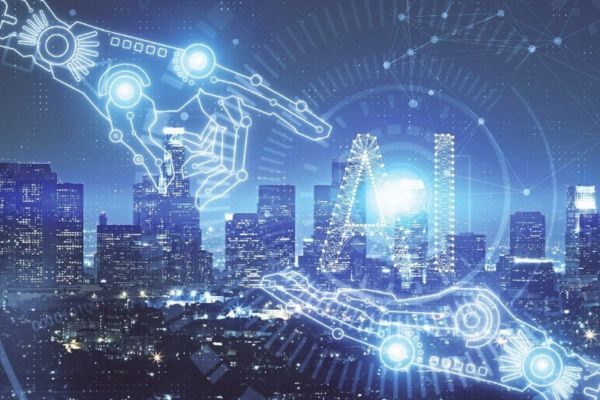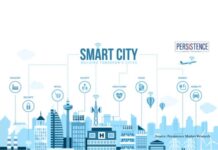The global AI in smart cities market size is expected to reach around USD 237.22 billion by 2034 and is poised to witness strong growth at a compound annual growth rate (CAGR) of 17.92% over the forecast period from 2025 to 2034.
AI in smart cities refers to the use of intelligent systems and algorithms to solve urban challenges and enhance operational efficiency across domains such as transportation, energy, healthcare, safety, and governance. These systems rely on real-time data from sensors, cameras, and connected devices to automate decisions, optimize city services, and support proactive planning.
The market for Artificial Intelligence (AI) in smart cities is experiencing rapid expansion, fueled by technological advancements and the global push for sustainable urban living. Market reports indicate significant growth in the coming years, as investments surge in areas such as transportation, energy optimization, and smart infrastructure.
Governments and private sectors alike are turning to AI to enhance urban infrastructure and improve the quality of life for residents. The proliferation of IoT (Internet of Things) devices has accelerated this trend, providing cities with vast amounts of data that AI systems can analyze to make intelligent, real-time decisions. As urban populations grow and city management becomes more complex, AI is emerging as a cornerstone of modern urban development. Surveys suggest that over 60% of cities globally are adopting AI technologies in at least one area of city life, with investment levels continuing to rise.
What are the importance of AI in Smart Cities?
1. Urban Planning & Infrastructure
- AI analyzes large datasets (traffic flow, population density, resource use) to help city planners make smarter decisions.
- It helps predict urban growth, optimize land use, and plan sustainable infrastructure.
2. Traffic Management
- AI enables real-time traffic monitoring and adaptive traffic signals, reducing congestion and improving road safety.
- Supports smart parking systems that guide drivers to available spots, saving time and reducing emissions.
3. Energy Efficiency
- AI optimizes energy distribution by analyzing usage patterns, integrating renewable sources, and minimizing waste.
- Supports smart grids that balance energy loads in real-time and reduce outages.
4. Waste Management
- Smart bins and AI-powered sensors track waste levels, optimizing collection routes and schedules.
- Promotes recycling through image recognition and sorting technologies.
5. Public Safety & Security
- AI enhances surveillance with facial recognition and behavioral analysis to detect suspicious activities.
- Supports emergency response systems by predicting crime hotspots and allocating resources efficiently.
6. Healthcare Services
- AI helps monitor public health trends (e.g., disease outbreaks) and can support telemedicine and predictive care.
- Wearables and city-wide sensors can alert healthcare providers to emergencies in real-time.
7. Environmental Monitoring
- AI models can track air and water quality, noise pollution, and weather patterns.
- Enables early warning systems for natural disasters like floods or wildfires.
8. Citizen Engagement
- Chatbots and AI-driven apps help citizens interact with city services more efficiently.
- AI can analyze feedback from social media or service portals to identify issues and improve service delivery.
9. Data-Driven Governance
- AI aids in policy-making by analyzing trends and simulating outcomes.
- Promotes transparency and accountability through data visualization and predictive analysis.
Segmental Insights of AI in Smart Cities Market
Application Insight
Traffic Management: AI optimizes traffic flow by analyzing real-time data from sensors, cameras, and vehicles. It predicts traffic patterns, dynamically adjusts signals, and guides drivers through congestion-reducing routes—leading to shorter commutes, lower emissions, and improved road safety.
Public Safety & Security: AI enhances urban safety with surveillance, facial recognition, and predictive analytics. It helps identify crime hotspots, streamline emergency responses, and monitor public areas—allowing faster, more proactive law enforcement.
Energy Management: AI-driven systems improve energy efficiency by forecasting demand, integrating renewables, and managing consumption across smart grids and buildings. This reduces energy costs and supports sustainable energy transitions.
Infrastructure Management: AI monitors critical infrastructure like roads and bridges using IoT sensors. It can detect wear, predict failures, and enable preventative maintenance, which extends asset life, reduces downtime, and improves reliability.
Environmental Monitoring: AI processes data from air quality sensors, satellites, and weather stations to manage pollution, optimize waste collection, and track emissions. These tools help cities meet climate targets and protect public health.
Smart Governance: AI supports city administration by streamlining services, automating tasks (e.g., permits, service delivery), and enhancing citizen engagement. It promotes transparency, efficiency, and responsive governance.
Technology Insight
Machine Learning: Enables systems to learn from historical and real-time data to predict urban trends—such as traffic congestion or energy demand—leading to smarter planning and resource use.
Natural Language Processing (NLP): Empowers AI chatbots and virtual assistants for citizen services. NLP enables easy, natural-language interactions and helps cities understand public sentiment from online feedback.
Computer Vision: Used in traffic surveillance, public safety, and waste management. It allows systems to interpret visual data, detect anomalies, and automate monitoring tasks.
IoT Integration: AI processes real-time data from smart devices—like meters, streetlights, and sensors—creating a responsive, interconnected urban environment.
Big Data Analytics: AI-powered analytics help cities understand massive datasets from energy systems, transport, and public services. These insights drive smarter decisions and better urban outcomes.
Deployment Modes Insight
Cloud-Based Solutions: Offer scalability, remote access, and ease of implementation. Ideal for growing data volumes and cross-department collaboration, cloud AI solutions lower infrastructure costs and speed up deployment.
On-Premises Solutions: Preferred where data privacy, real-time processing, and security are top priorities—such as public safety. While costlier, these solutions give cities full control over data and operations.
AI in Smart Cities Market Regional Insight
North America: Leading the AI in smart cities market, driven by significant investment and innovation in smart infrastructure, traffic systems, and public safety. The U.S. and Canada are pioneers in AI deployment across urban services.
Europe: A strong contributor, with a focus on sustainability, smart governance, and green tech. Countries like Germany, France, and the UK are advancing regulatory frameworks and AI implementation in energy, environment, and public services.
Asia-Pacific: Rapidly advancing with massive infrastructure projects in China, India, and Japan. AI is being integrated into urban planning, transportation, and energy systems to accommodate fast-paced urban growth.
LAMEA (Latin America, Middle East, Africa): Emerging as a promising market. Countries like Brazil and South Africa are investing in smart city initiatives, while the Middle East is pushing AI integration despite infrastructure and economic challenges.
Dive deeper into insights@ https://www.cervicornconsulting.com/sample/2390

















